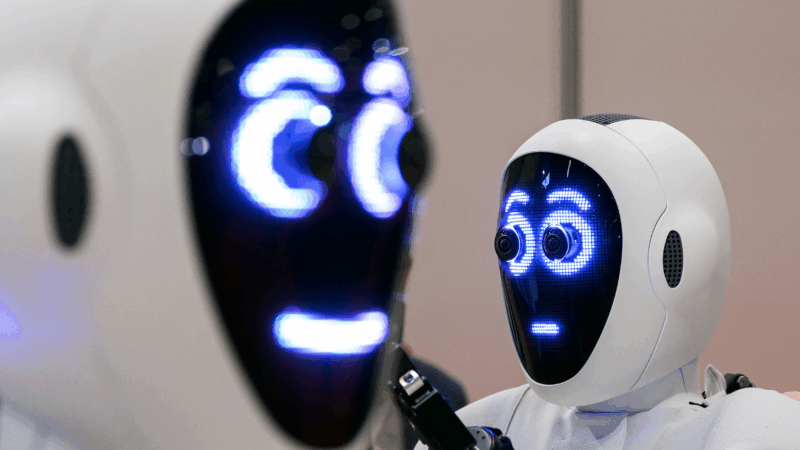It’s 2025, the year we decided we need a widespread slur for robots
Debate over the song of the summer rages on, but if there were a contest for a word of the summer, one front runner would surely be the onomatopoeiac, clanker.
In recent weeks clanker has risen to viral levels on TikTok and Instagram. One popular video from July shows a delivery robot on wheels – the kind that looks like a mobile cooler with flashing lights that look like eyes – stopped on a patch of grass on the side of a road. As a man and woman drive past it, they point and shout, “Filthy … Get these off the streets. Clanker! Clanker! Clanker!”
Even with little background, it’s clear from context clues that clanker is not a good thing, but in this installment of Word of the Week we will answer – what exactly does it mean?
Adam Aleksic, a linguist, author and content creator best known across social media as the @etomologynerd, told NPR it’s a derogatory term for robots that stems from the Star Wars universe dating back to 2005. “It was referenced in Star Wars and in the Clone Wars series. They would call robots clankers because of the sound they made. It clearly implies clanking. … And then we adopted it because it sounds useful.”
While other sci-fi franchises and fandoms have created their own lexicon that included robot slurs — Battlestar Galactica and Blade Runner both used skin-job as a pejorative for human-appearing robots — Aleksic said, those terms didn’t really catch on because they didn’t make as much sense. He noted that clanker has already had a long life on Star Wars’ subreddits, specifically subreddits about the Battlefront video game, and as a meme, where people use it to belittle robots. The reason clanker is going mainstream now is because it’s fulfilling a need as we see more robots in our everyday lives, according to Aleksic. And he adds, it has now evolved to generative AI platforms like ChatGPT.

“I remember tweets from January of this year where people were saying, ‘Oh, we need a slur for AI’ And finally, it seems like that cultural need is being met,” he said.
Just last week, Sen. Ruben Gallego, D-Ariz., promoted his latest bill on X, using the insult. “Sick of yelling ‘REPRESENTATIVE’ into the phone 10 times just to talk to a human being? My new bill makes sure you don’t have to talk to a clanker if you don’t want to,” he wrote.
Aleksic said the use of the word inherently creates an outgroup. An us vs. them mindset. But the irony, he noted, is that in attaching the word to non-sentient creations (at least for now) it anthropomorphizes robots akin to an ethnic group or a people group. “And at the same time, it brings them up to the level of humans to even be dehumanized in the first place. So ironically, the people saying clanker, are assigning more of a personality to these robots than actually exists.”
Many of the memes circulating now zero in on the xenophobia of it all, and what social media users are calling, robot racism or robophobia. Using existing stereotypes and tropes, they joke about a not too distant future where robots are ubiquitous as second-class citizens, facing discrimination in the same ways that Black people and other racial or ethnic groups in America have historically faced.
In one video with over 7.7 million views, TikTok user @vibestealer, who is a young Black man, pretends it’s 2044 and his daughter has brought home a robot boyfriend. Ominous music plays in the background as he asks about the robot’s intentions, while coughing the words “clanker” and “garbage” into his fist. “I don’t want you anywhere near my daughter!,” he yells at one point.
Another popular iteration of the meme features people pretending to apologize to their future robot overlords for past anti-robot transgressions, including use of the “c-word.”
The robots are coming for us all

The spread of clankers comes as AI is fundamentally transforming work and the workplace as we know them.
“We have a social need right now to respond to the proliferation of AI, especially when AI is taking human jobs, especially when they’re replacing online creators,” Aleksic said.
A 2023 Pew Research Center survey found that the majority of Americans are wary about the use of AI in the workplace. Sixty-two percent said they think the use of AI at work will have a major impact on workers over the next 20 years. About a third believe the benefits and harms will be equally split for workers. Meantime, 22% are uncertain about its potential effect.
Perhaps no other generation is feeling this more acutely than Gen Z, many of whom are now graduating from college. As NPR reported, economists believe that the 2025 job market is the most challenging in the last decade — not counting the pandemic period. And that is likely to worsen within a generation.
“To be clear on a longer time horizon, and by longer we’re talking about 15 to 20 years, not 50 or a hundred years, there will be virtually nothing that a human being can do that a machine can’t do as well or better for a tiny fraction of the cost,” Adam Dorr, the director of Research for Rethinx, a nonprofit nonpartisan think tank that focuses on understanding disruptive technology, told NPR. “That’s simply where the technology of artificial intelligence and robotics and automation is headed.”
For now, he said, we are living in a grace period, where AI will enhance the work that we do. “They will turbocharge our productivity. They will complement the human workforce.”
In Dorr’s view, which he describes as optimistic, this creates a chance for a world in which humans will be free from toil. The drudgery that is work and making and distributing products will be shifted onto robots and AI leaving people liberated in a way they never have been before. And there is no time to waste in creating a brand new framework for it.
“There’s definitely an urgency to this entire situation. But it doesn’t mean that it’s a cause for panic. It’s not a crisis, and it’s not a catastrophe yet,” he said.
The question is, will we still be saying clanker in that world?
Memory loss: As AI gobbles up chips, prices for devices may rise
Demand for memory chips currently exceeds supply and there's very little chance of that changing any time soon. More chips for AI means less available for other products such as computers and phones and that could drive up those prices too.
Brigitte Bardot, sex goddess of cinema, has died
Legendary screen siren and animal rights activist Brigitte Bardot has died at age 91. The alluring former model starred in numerous movies, often playing the highly sexualized love interest.
For Ukrainians, a nuclear missile museum is a bitter reminder of what the country gave up
The Museum of Strategic Missile Forces tells the story of how Ukraine dismantled its nuclear weapons arsenal after independence in 1991. Today many Ukrainians believe that decision to give up nukes was a mistake.
Jeffrey R. Holland, next in line to lead Church of Jesus Christ of Latter-day Saints, dies at 85
Jeffrey R. Holland led the Quorum of the Twelve Apostles, a key governing body. He was next in line to become the church's president.
Winter storm brings heavy snow and ice to busy holiday travel weekend
A powerful winter storm is impacting parts of the U.S. with major snowfall, ice, and below zero wind chills. The conditions are disrupting holiday travel and could last through next week.
Disability rights advocate Bob Kafka dead at 79
Bob Kafka was an organizer with ADAPT (American Disabled for Attendant Programs Today), a group which advocates for policy change to support people with disabilities.









